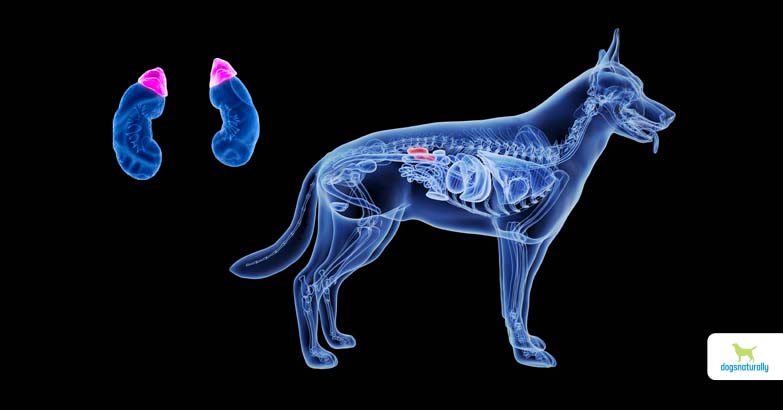If your vet has diagnosed your dog with Cushing’s disease (or suspects it) … this post is essential reading!
Cushing’s disease is a common diagnosis in middle-aged dogs. But it often gets “over-diagnosed.”
This is a polite way of saying “your dog never had it in the first place.” And that’s a problem.
So I want to explain how that can happen. But first … it’s important to fully understand this disease.
What Is Cushing’s Disease In Dogs?
Cushing’s disease is an endocrine disorder of middle-aged and older dogs. It’s the result of the overproduction of cortisol by the adrenal glands located on each kidney.
Normally, your dog responds to stress by producing something called ACTH (adrenocorticotropic hormone). ACTH is a hormone produced by the pituitary gland, which is a pea-sized gland at the base of the brain. This release of ACTH stimulates his adrenals to produce more cortisol (or cortisone), which is the body’s main stress hormone.
In Cushing’s disease, the adrenals produce really high levels of cortisol hormone continually. Cushing’s disease can be the result of 3 possible situations:
#1 Your dog has a microscopic benign tumor of the pituitary gland.
This tumor overproduces ACTH. That stimulates the adrenal glands to produce too much cortisol. About 85% of Cushing’s cases in dogs are due to a pituitary tumor.
#2 Your dog has an adrenal gland tumor.
Tumors on the adrenal gland can produce excess cortisol levels. This is the case in about 15% of dogs.
#3 A veterinarian prescribes excessive steroids as a medication.
Corticosteroid drugs including cortisone, hydrocortisone and prednisone can cause Cushing’s disease in dogs. With NSAIDs (non-steroidal anti-inflammatory drugs), the incidence of this is waning.
RELATED: Why you shouldn’t give your dog NSAIDs …
Symptoms Of Cushing’s Disease In Dogs
- Drinking or urinating a lot
- Sagging, bloated, pot-bellied appearance
- Panting excessively
- Extra hungry or stealing food
- Weight gain
- Weak hind legs
- Loss of muscle mass
- Coat and skin are thinning
- Pigmented skin
- Gets skin infections
Why There’s A Problem
When it comes to misdiagnosing Cushing’s disease in dogs, there are two problems to contend with:
- Tests that determine if your dog has Cushing’s disease are expensive and can be unreliable.
- One commonly used drug to treat Cushing’s is Lysodren, which will destroy your dog’s adrenal glands. This just compounds the problem created by an incorrect diagnosis.
But why would there be a misdiagnosis?
To answer that, let’s start at the very beginning using a typical experience that might very well happen to you and your dog. Let’s name your imaginary dog Spot.
Spot is over 6 years old. You take him in for his annual examination where he gets his annual blood test.
Spot has no symptoms of Cushing’s disease in dogs. He only has elevated alkaline phosphatase.
This is a liver enzyme … and if it’s 2 to 3 times the normal range, Cushing’s disease is often pegged as the likely problem.
But any disorder causing endogenous stress can cause high alkaline phosphatase in dogs.
(Endogenous means it comes from inside your dog, not external factors.)
False Positive Tests
Cushing’s disease seems to be on every veterinarian’s mind these days. Because of this, they often recommend screening tests for Cushing’s disease.
These tests are relatively reliable IF your dog has signs and symptoms as well as lab abnormalities.
But what if these same tests are used on animals who don’t have these signs and symptoms? (Like our imaginary friend Spot!) That’s when false positive results can occur.
Another factor is that these tests are done at the veterinary hospital. And that has a big impact too …
Your dog is caged for about 8 hours … so the stress of hospitalization alone may cause a false positive result. Even the thought of going to the vet is enough to start your dog’s adrenals working overtime.
Testing For Cushing’s Disease In Dogs
Because of its sensitivity, many vets consider the Low Dose Dexamethasone Suppression Test the best option. But the problem with this test is it gives too many false positive results.
As I said before, the stress your dog goes through can influence the test results. Being locked in a cage and having blood drawn is definitely enough stress to create a false positive.
Another test called the ACTH Stimulation Test is also a popular screening test. But I couldn’t tell you why!
In general, this kind of test would be used for hypofunction (Addison’s) … not hyperfunction … of the adrenal glands. This test misses many animals that have the disorder … typically 20% to 30% of dogs with pituitary abnormality and 50% with an adrenal tumor.
Your vet should only use these tests when your dog has clinical signs of the disease. In other words, all the signs I mentioned above that Spot didn’t have.
A Better Test
There’s an excellent test you can do on your dog’s urine called a Cortisol-Creatinine Ratio Test. This test is very useful for ruling out Cushing’s disease. And it has a 90% accuracy rate.
The urine has to be taken at home and your dog mustn’t be stressed out. So don’t even tell him he might be going to the vet’s office later on that day!
When you bring the urine sample for testing, ask the veterinarian to do a urine specific gravity.
- A urine specific gravity of less than 1.025 is consistent with Cushing’s disease.
- Dogs with a urine specific gravity greater than 1.025 are less likely to have Cushing’s.
This is by far the most accurate, safe and effective method of diagnosing Cushing’s disease. If this test shows an elevated Cortisol-Creatinine ratio, you’ll also want to follow up with an ultrasound. I’ll talk about this next.
Making Decisions
Let’s go back to Spot for a minute …
- Spot has none of the signs and symptoms of Cushing’s disease.
- He has high alkaline phosphatase.
- His Cortisol-Creatinine ratio is elevated.
The best thing to do is find a specialty clinic with a radiologist who does ultrasounds. Ask for a full abdominal ultrasound and have the doctor check and size both adrenals.
If they’re normal in size, and your dog has no symptoms, it’s very likely your dog doesn’t have Cushing’s disease.
What About Atypical Cushing’s Disease?
There’s another misunderstanding called atypical Cushing’s disease. I’m convinced that a dog diagnosed with Cushing’s without corresponding symptoms doesn’t have the disease.
While there is such a thing as atypical Cushing’s disease, it’s not what most people think it is. About 10 years ago, veterinarians at the Royal Veterinary College in England did a study. The dogs they observed …
- Drank a lot of water
- Urinated a lot
- Had urine specific gravities below 1.025
- Had pot-bellied appearances
- Showed muscle wasting
- Had weakness in the hind legs
- Had ravenous appetites and excessive panting
But their Low Dose Dexamethasone Suppression test and ACTH Stimulation tests came back normal. And they all got better on Lysodren.
So these vets did some excellent research …
They found that every dog had an elevated sex steroid called 17-hydroxyprogesterone. This was thought to be a marker … or possibly the cause … of all the Cushing’s disease symptoms.
Yes, these dogs with atypical Cushing’s disease had all the symptoms of the disease. But in the end a different hormone was causing these symptoms.
Facts About Cushing’s Disease In Dogs
It’s important to know all the facts about Cushing’s disease in dogs. This disease is presently being diagnosed at earlier stages in life. But a dog should still have some of the symptoms and a low urine specific gravity to consider it.
Both Trilostane and Lysodren are detoxed by the liver. In fact, it’s clearly stated that you shouldn’t give Trilostane to a dog who has kidney or liver disease. So there’s no good reason to place an animal with a liver problem and no Cushing’s disease on either of these drugs.
I wanted to bring you the very best information on Cushing’s syndrome, so I spoke with Dr Rhett Nichols. Dr Nichols is a world-renowned expert in endocrinology. He said:
“I believe these tests are reliable if used properly. A major point that should be made is that any screening test for any disease should only be applied to a population of animals/people where it is likely they have the disorder based on history, physical exam findings, and lab work. If a screening test is applied to animals where the disorder is unlikely, false positives (outliers) are going to occur. Bottom line? The screening tests are not bad, but their use in certain situations (eg high ALP with no clinical signs, sick animals with no signs consistent with Cushing’s) is questionable.”
Holistic Management Of Cushing’s Disease In Dogs
What if your dog really does have Cushing’s disease? Is there anything holistic you can do?
I’ve used homeopathic ACTH with some success and Chinese herbs with great success. The most effective Chinese herbs I’ve used, from the Chi Institute of Chinese Medicine, are:
- Rehmannia 11
- Rehmannia 14
- Ophiopogon Powder
- Liver Happy
You can get these herbal combinations from a variety of Chinese herb companies.
RELATED: 4 natural remedies for Cushing’s disease in dogs …
Knowing the facts and understanding how the testing procedure for Cushing’s disease works is important. This info will help save you unnecessary expenses and worry.
Both pickles and Cushing’s disease can make you thirsty … but there’s no need to be in a pickle with Cushing’s.












